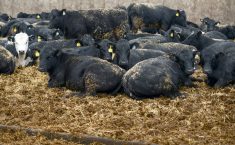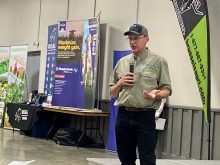[UPDATED: April 1, 2020] Brent Saunders and his family have moved their 15th annual Charolais bull sale online.
They are one of many farms with bull sales scheduled across the country challenged by group gathering restrictions because of COVID-19.
Bull sales are a main source of income for many producers, and still the way many buyers procure the bulls to breed their beef cattle.
Why it matters: Tips for livestock events that still need to go on are useful for any event still being run during the COVID-19 crisis.
Read Also

BinSentry sensors reduce feed-bin outages
BinSentry sensors mean fewer feed bin outages and more efficient deliver for feed mills.
Saunders, who farms in the Markdale area, says they usually hold their sale with their 30 bulls and another six bulls from a Simmental breeder consignor at the Keady Livestock Market.
“We just saw the way things were going. Things were shutting down more and more. We thought we’d get ahead of it,” he said. They held an open house and welcomed people who wanted to see the bulls in advance of the April 4 sale. It will now be held online by DV Auction.
“It will be a bit of a learning curve for us for sure,” he said.
Livestock sales, traditionally made in person are another area being disrupted by COVID-19. Ontario auction markets continue to be open, filling the critical role of keeping animals moving through the food system. They have, however, closed to visitors and recommend limiting attendance.
The Livestock Markets Association of Canada, Canadian Beef Breeds Council and the Canadian Cattlemen’s Association recently distributed a list of recommendations for those hosting sales:
Those hosting sales should:
- make cattle available for viewing prior to the sale
- make on-line or phone bidding available where possible
- limit attendance to less than 50 people (Ontario’s limit is now no more than five people at a gathering)
- consider online photos and videos as an alternative
- restrict general public access
- do not shake hands and maintain a social distance of two metres
- provide information to employees on COVID-19
- provide hand sanitizer in common areas
- provide space for hand washing
- consider not providing food
- frequently sanitize workstations and pay special attention to telephones, computer keyboards, calculators, desks, photocopiers, counters and common areas, shared by more than one person on a regular basis.
Those buying cattle and attending sales should:
- where possible view bulls ahead of the sale
- not attend sales without an intention to buy or seriously considering buying
- not attend a sale if sick with even mild symptoms
- send one person per farm operation
- not shake hands and maintain a two-metre social distance
- consider phone bidding
- consider online bidding
- consider online photos, video as alternative to in person viewing
- wash hands thoroughly and frequently
– With files from Western Producer
Update: Added information about Ontario’s limit on gatherings.















